Chromidotilapia guntheri
Classification
Order: Perciformes Family: Cichlidae
Distribution
Described from Assinie-Mafia in south-eastern Côte d’Ivoire (Ivory Coast), western Africa but currently accepted to be extensively distributed in coastal river drainages of central western Africa from the Saint John River, central Liberia to the Cross River drainage, in southeastern Nigeria and southwestern Cameroon. It also occurs in the Niger and its major tributary the Benue (Bénoué) and has thus been recorded from Benin, Burkina Faso, Cameroon, Côte d’Ivoire, Equatorial Guinea, Ghana, Guinea, Liberia, Mali, Niger, Nigeria and Togo.
A putative subspecies, C. g. loennbergi, is endemic to the volcanic crater lake Barombi-ba-Kotto, south-western Cameroon plus some surrounding waters and is currently regarded as ‘Critically Endangered‘ by the IUCN, not only due to its limited range but also deforestation, water abstraction and other human activities in the area. It remains unclear whether it should be regarded as a distinct species or population of C. guntheri, however.
Habitat
Almost exclusively inhabits lowland environments including coastal floodplains, savannahs and forested regions where it apparently prefers calmer habitats with submerged cover such as tree roots and fallen branches.
Maximum Standard Length
Aquarium SizeTop ↑
Minimum base dimensions of at least 120 ∗ 30 cm for a single pair are recommended.
Maintenance
Ideally a soft, sandy substrate should be used in order that the fish are able to browse naturally (see ‘Diet’). Additional furnishings are as much a case of personal taste as anything else but the most favoured set-ups tend to feature relatively dim lighting plus some chunks of driftwood and scattered roots/branches. One or two flattish, water-worn rocks can also be included to provide potential spawning sites if you wish.
Water quality is of the utmost importance since these cichlids are susceptible to deteriorating water quality and should never be introduced to a biologically immature aquarium. The best way to achieve the desired stability is to employ an efficient filtration system and perform weekly water changes of 30-50% tank volume.
Water Conditions
Temperature: 24 – 27 °C
pH: 6.0 – 8.0
Hardness: 18 – 268 ppm
Diet
Chromidotilapia spp. are benthophagous omnivores by nature feeding on small invertebrates, algae, organic detritus, shrimp eggs, etc.. They often employ a browsing behaviour comparable to that seen in some South American cichlid genera such as Geophagus and Satanoperca whereby mouthfuls of substrate are taken and sifted for edible items with the remaining material expelled via the gills and mouth.
In aquaria they aren’t difficult to feed provided the diet is relatively low in protein. Offer sinking prepared foods containing a high proportion of vegetable matter such as Spirulina or similar supplemented with the occasional meal of live or frozen chironomid larvae (bloodworm), Daphnia, Artemia or mosquito larvae.
Home-made, gelatine-bound recipes containing a mixture of dried fish food, puréed shellfish plus fresh fruit and vegetables should also work well and can be cut into bite-sized pieces using the end of a sharp pipette or small knife.
Behaviour and CompatibilityTop ↑
Can be maintained in a community provided tankmates are properly researched and chosen with care. Peaceful, pelagic characids and cyprinids represent ideal choices and other cichlids can also be kept provided they don’t compete excessively for territorial space and food.
For breeding purposes C. gunteri is best kept alone or with a group of small-mouthed, non-predatory ‘dither’ fish. Though not especially aggressive compared with some related fishes members of this genus are non-gregarious once adult and bonded pairs are highly territorial meaning it’s best just to keep a single pair in the majority of cases.
Sexual Dimorphism
Apart from the difference in adult size the first pectoral fin ray in males is more extended than in females. When in spawning condition females exhibit a reddish pink abdomen and the whitish band in the upper part of the dorsal fin becomes more vivid.
Reproduction
Biparental, paternal, substrate–spawning, ovophilic mouthbrooder. The male collects the entire brood in his mouth immediately post-fertilisation and solely responsible for brooding duties while the female defends the surrounding territory. Incubation and absorption of yolk sacs normally takes 10-14 days a which point the fry are large enough to accept Artemia nauplii or similarly-sized foods. Brood care continues for at least a further two weeks, sometimes longer, and when threatened the fry may take refuge in the mouths of both parents.
NotesTop ↑
Given the extent of its range this species unsurprisingly occurs in a number of geographic forms with populations from Cameroon tending to exhibit a number of dark blotches on the dorsal fin, for example. Within the family Cichlidae Chromidotilapia is a member of the informally-recognised chromidotilapiine clade.
References
- Lamboj, A., 2002 - Ichthyological Exploration of Freshwaters 13(3): 251-256
Chromidotilapia mrac, a new species of Cichlidae (Teleostei: Perciformes) from Gabon. - Lamboj, A., 2003 - Zootaxa 143: 1-15
Chromidotilapia melaniae and C. nana, two new cichlid species (Perciformes, Cichlidae) from Gabon, Central Africa. - Lamboj, A., 2004 - Birgit Schmettkamp Verlag: 1-256
The Cichlid Fishes of Western Africa.

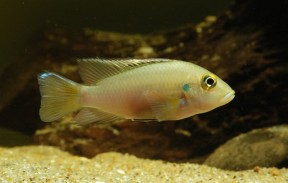
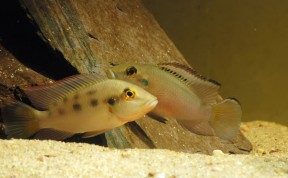

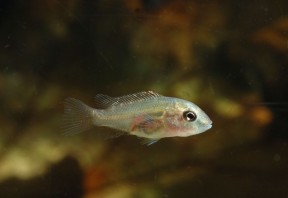
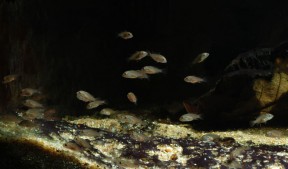
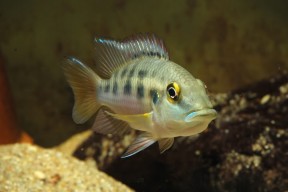

June 18th, 2017 at 4:41 am
What’s with the size of the fish? Pretty sure they aren’t 60″40″ lol.